Few things are more intimidating in the sphere of language than unfamiliar scripts. For those used to working with the Roman alphabet, staring at the Arabic or Devanagari script can cause serious palpitations. Toss in Chinese characters, and it’s all over. Japanese manages to take it to a whole other level, somehow mixing Chinese characters, two other sets of signs known as kana, and a few Roman letters! Amazingly, the Japanese language in its spoken form is less challenging for an English speaker than would be expected. Here are 10 tidbits about the language you should know. (As is often the case, we used one of our favorite books, Babel, as a resource.)
1
Japanese, or Nihongo, has approximately 130 million speakers, with the vast majority being native speakers located in Japan. It is the 13th most-spoken language in the world, just behind German.
2
Japanese is, of course, the de facto official language of Japan. It is the de jure official language in only one location in the world, namely Angaur, a 119-person state in the island nation of Palau. Japanese can also be commonly heard where large emigrant communities are found, including Brazil and the U.S. Elderly people in places that were part of the pre-World War II Japanese empire (e.g. the Korean peninsula, Taiwan, and the Philippines) might still speak the language.
3
Japanese does not cleanly fit into any broad language family. As such, it is sometimes called a Japonic language. This group consists of Japanese and the endangered Ryukyuan languages that are spoken in the Ryukyu Islands (the southernmost islands in the Japanese archipelago). Also included is Hachijō, another endangered language that is spoken in the country’s Izu Islands. These languages arose from a mix between those spoken by the Jōmon (the archipelago’s original inhabitants) and the Yayoi people, who began populating the islands from modern-day Korea and/or China during the first millennium BCE.
4
Standard Japanese is largely based on the Tokyo dialect. The overall number of dialects is up for debate, though several sources have whittled the number of major additional dialects down to seven.
5
Japanese has no grammatical gender. That said, women and men actually speak slightly different genderlects. A super simplistic explanation is that women use certain words and pronunciations that are more likely to come across as polite. Of course, in modern times, the linguistic gender gap appears to be closing.
6
As mentioned above, written Japanese can be remarkably complex—in fact, the language is considered by many to have the most complex writing system in use. A few thousand Chinese characters (kanji), most with multiple pronunciations, are a key part of the picture. Two different sets of signs (kana), totaling in the hundreds, are tossed in. And in modern times, some Roman letters make the cut, adding to the chaos.
7
Just to add a layer of intrigue to an already complicated situation, written Japanese does not incorporate spaces. In other words, readers must determine where one word ends and another begins. As a final twist, Japanese can be written vertically (with columns being read from right to left) or horizontally (with rows being read from left to right).
8
Japanese is known for its pitch accent, where parts of words are accented by changes in pitch (as opposed to the changes in stress used in English). This phenomenon often serves as a sure-fire way to stand out as a foreign speaker.
9
Japanese has acquired a host of loan words over the centuries, with Chinese languages donating generously. During Japan’s isolationist period from the 17th to 19th centuries, trade with the Dutch was allowed, explaining the unexpected number of Dutch words in the language. More recently, English has become a prominent donor, as it has for many languages.
10
The English language is loaded with words of Japanese origin. Examples include anime, bonsai, edamame, emoji, futon, ginkgo, haiku, hibachi, judo, kamikaze, karaoke, karate, ninja, origami, ramen, sake, samurai, sudoku, sushi, teriyaki, tsunami, and tycoon. Here is a more complete list.
Despite our borderline pep talk at the outset of this piece, we’re not going to tell you to run out and learn Japanese unless you have a lot of time and/or interest. If you don’t fall into that category, you can just give the ramen noodle package an extra-special glance before your midnight snack.
